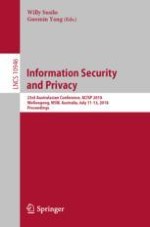This book constitutes the refereed proceedings of the 23rd Australasian Conference on Information Security and Privacy, ACISP 2018, held in Wollongong, Australia, in July 2018.
The 41 revised full papers and 10 short papers presented were carefully revised and selected from 136 submissions. The papers present theories, techniques, implementations, applications and practical experiences on a variety of topics such as foundations, symmetric-key cryptography, public-key cryptography, cloud security, post-quantum cryptography, security protocol, system and network security, and blockchain and cryptocurrency.
